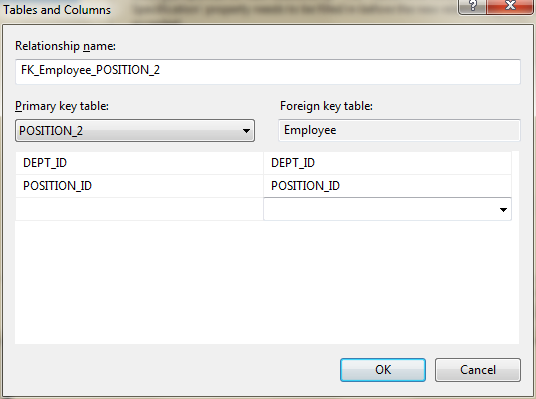Microsoft SQL Server
--
Questions
--
Followers
Top Experts
I have 4 tables
Depts:
Dept_ID int PK,
Dept_Name varchar(25)
Dept_To_Dept
Dept_ID int PK
Dept_Group_ ID int PK
Position:
Dept_Group_ID Int PK
Position_ID Int PK
Employee: (Lots of columns but these are the only 2 relevant)
Dept_ID int
Position_ID intEach employee has a dept ID and a position ID.
The employee.Dept ID FK to Depts.Dept_ID.
Depts_To_Dept.Dept_id FK to DEPTS.Dept_ID
Now I am trying to get the Position_ID from employee and Dept_Group_ID from Dept_To_Dept to join to Dept_ID and Position_ID in Position table but can't get it to work as Dept_Group_ID is not unique or Position_ID is not unique but they are unique together.
I know this might not make sense so please ask any questions you want so I can try an clarify.
Thanks in advance
Zero AI Policy
We believe in human intelligence. Our moderation policy strictly prohibits the use of LLM content in our Q&A threads.
ALTER TABLE Position
ADD CONSTRAINT PK_Position
PRIMARY KEY (Dept_Group_ID , Position_ID) Can you post here a screenshot with the error?






EARN REWARDS FOR ASKING, ANSWERING, AND MORE.
Earn free swag for participating on the platform.
in THe second Diagram you can see where I tried to build a junction table but I still can't get Position_ID from Employee to mix with it as each dept uses the same position IDs but its the Dep_ID + Position_ID makes it unique
Thank you for you response but the naming convention I'm stuck with seems like it put you off.
Position_2. Dept_ID matched Dept_To_Dept.Dept, and Employee.Dept_ID matched both Dept_Dept_id and Dept_To_Dept.Dept_ID
So there is no direct way to match Dept_ID from Employee to Position_2
It would make more sense if Position_2.Dept_ID was called Position_2.Dept_Group and Dept_To_Dept.Dept was Dept_To_Dept.Dept_Group

Get a FREE t-shirt when you ask your first question.
We believe in human intelligence. Our moderation policy strictly prohibits the use of LLM content in our Q&A threads.
Now is there a way I can show that relationship without showing the Query.
I normally do/did everything in stored procedures (I am a C# developer) but my boss wanted me to show the relationship in a SQL Diagram (which I have never done before)
If it is not possible I will try to show the query and hope he understands.
Microsoft SQL Server
--
Questions
--
Followers
Top Experts
Microsoft SQL Server is a suite of relational database management system (RDBMS) products providing multi-user database access functionality.SQL Server is available in multiple versions, typically identified by release year, and versions are subdivided into editions to distinguish between product functionality. Component services include integration (SSIS), reporting (SSRS), analysis (SSAS), data quality, master data, T-SQL and performance tuning.
